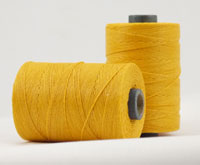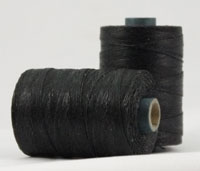

What tools do I need in my case to help me maintain my Bagpipes?
by Ian Lyons
Maintaining a set of bagpipes is probably the most important factor in being able to create and sustain a steady and nice sounding instrument and assist you with learning to play steadily and produce good tone.
There are a few items that every bagpipe player should have in their pipe case to help them maintain their bagpipes and also help them to deal with on the spot adjustments and repairs.
Each item has particular uses and are readily available from most bagpipes and accessories shops.
Probably the most used maintanence item is, what is commonly referred to as Hemp. Hemp is a type of thread used for binding the joints on bagpipes and is generally made up of 3 cords of reverse twisted linen which makes it very strong and difficult to break. The picture below shows a Pre-waxed variety of hemp which has become very common and replaces the use of the traditionally used yellow hemp which has to be manually waxed using a roset of cobblers black wax or beeswax. Yellow Pre-waxed Hemp or Black Pre-waxed Hemp makes for a perfect joint which, if applied well, can last for a few years but many pipers still prefer to apply the wax manually.
Below is a picture of a roll of Yellow Hemp which is un-waxed and also a roset of Cobblers Wax and a roset of Beeswax in a convenient Holder.
The next item that most pipers will need is some type of knife to use for cutting various things including hemp, tape and other items whilst performing maintanence duties. A Hobby Knife as shown in the picture below is perfect in size and shape to perform most of the tasks. Because it has a razor sharp blade it is perfect for cutting hemp and tape. It also has a perfectly shaped pointed blade for undercutting holes on the pipe chanter, if ever neccessary. It comes complete with a protective sheath and replacement blades can also be purchased to ensure the blade is always sharp.
The next few items used in the maintenance of bagpipes are for the purpose of cleaning and nurturing the wood to keep it free from build up of dirt, germs and also to keep the wood in good season. There are a few brushes that can be used to clean the bagpipes. The pictures below show a Set of 5 Brushes which are used for cleaning. The 5 brushes are various shapes to assist in the cleaning of all the different sized bores on the bagpipes. 3 are bristle brushes used for cleaning and the other 2 are soft cotton brushes used for cleaning, wiping and applying oil. The other long brush is a Chanter Brush for the pipe chanter. It is conical in shape and used to wipe clean the bore of the pipe chanter.
After cleaning the pipes using the various brushes, they can then be oiled to keep the wood well seasoned. Using Bore Oil is not always neccessary if the bagpipes are in regular use and always kept in good condition. Most woods contain natural oils and it is only neccessary to oil bagpipes once every year or sometimes every couple of years. Even then, only a very small amount of oil needs to be used. A Pull Through is neccessary to apply oil to the bores of the bagpipes. It has a small cloth which is attached to a string with a metal weight on the end. Apply a small amount of the bore oil to the cloth and then drop the weight down into each drone piece and pull the cloth through. This will apply an even coating of the oil to the bore. Leave for a few minutes and then wipe away any excess oil using a soft drone brush.
Rubber Bungs are used to block off either the drones or stocks. Large Rubber Bungs are used to block off the drone stocks whilst checking the pipe bag for airtightness or whilst seasoning a hide pipe bag. Medium Rubber Bungs are used to block off the drones by inserting them into the very top of each drone. This can assist whilst learning to tune drones individually or just playing without the drones going. Small Rubber Bungs have the same use as the medium sized but they are placed inside the drone by taking the drone top off and inserting into the small bore. The small rubber bungs are particularly handy in an unlikely emergency where a drone reed might fail to operate correctly or even fall into the bag. Because they are not visible they are hidden and would not be noticed and then the problem can then be rectified later.
For seasoning leather pipe bags, you can't go past the original 'Airtight' Seasoning formulated by R.G. Hardie & Son Bagpipes, Scotland. 'Airtight' Seasoning has been around for decades and it's ingredients ensure that pipers will get the most from the life of their hide pipe bags. Bag seasoning is formulated to keep the hide in good condition by keeping it moist and as airtight as possible.
Click on any of the photos or highlights for full details and instructions.
Most of the items shown on this page are available in the Lyons Bagpipes Maintenance Kit. The kits comes complete in a conveniently sized box which fits neatly into most pipe cases and contains almost everything needed to keep your bagpipes in good working order and to deal with most maintenance issues.
Any Questions:- sales@lyonsbagpipes.com
Website Created and Managed by Lyons Bagpipes & Highland Supplies©